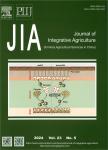Identification of Differentially Expressed Genes in the Salivary Gand of Rhipicephalus haemaphysaloides by the Suppression Subtractive Hybridization Approach
Identification of Differentially Expressed Genes in the Salivary Gand of Rhipicephalus haemaphysaloides by the Suppression Subtractive Hybridization Approach作者机构:Key Laboratory of Animal Parasitology Ministry of Agriculture~Shanghai Veterinary Research Institute Chinese Academy of AgriculturalSciences Shanghai 200241 P.R.China
出 版 物:《Journal of Integrative Agriculture》 (农业科学学报(英文版))
年 卷 期:2012年第11卷第9期
页 面:1528-1544页
核心收录:
学科分类:090603[农学-临床兽医学] 0710[理学-生物学] 07[理学] 08[工学] 09[农学] 0906[农学-兽医学] 071007[理学-遗传学] 0901[农学-作物学] 0836[工学-生物工程] 090102[农学-作物遗传育种]
基 金:the National Natural Science Foundation of China (31172095)
主 题:Rhipicephalus haemaphysaloides salivary gland suppression subtractive hybridization (SSH) cDNA library expression sequence tag (EST)
摘 要:For the purpose of screening and analyzing the differentially expressed genes from the salivary gland of Rhipicephalus haemaphysaloides, two salivary gland-subtracted cDNA libraries of partially fed female ticks and fed male ticks were constructed using suppression subtractive hybridization (SSH). A total of 247 female expression sequence tags (ESTs) and 168 male ESTs were obtained from the two SSH cDNA libraries. It is predicted that 25 female ESTs and 44 female ESTs contain the 5" and 3" ends, respectively, and that 53 male ESTs and 74 male ESTs contain the 5" and 3" ends, respectively. To identify the subtraction rate of the two SSH cDNA libraries, the RT-PCR method was used to test 24 female ESTs and 21 male ESTs selected randomly but not repeatedly. The results showed that there were 13 upregulated or differentially expressed genes in the partially fed salivary gland of the female R. haemaphysaloides and that the differentially expressed rate was 54%. In addition, they indicated that there were 9 upregulated or differently expressed genes in the fed salivary gland of the male R. haemaphysaloides and that the differentially expressed rate was 43%. Putative translations of 141 (57%) female ESTs and 125 (74%) male ESTs had similarity to GenBank sequences, and 32 (23%) female ESTs and 29 (23%) male ESTs exhibited similarity to tick proteins, which showed that most of the proteins in the libraries were mainly related to the feeding blood physiology of the ticks.



